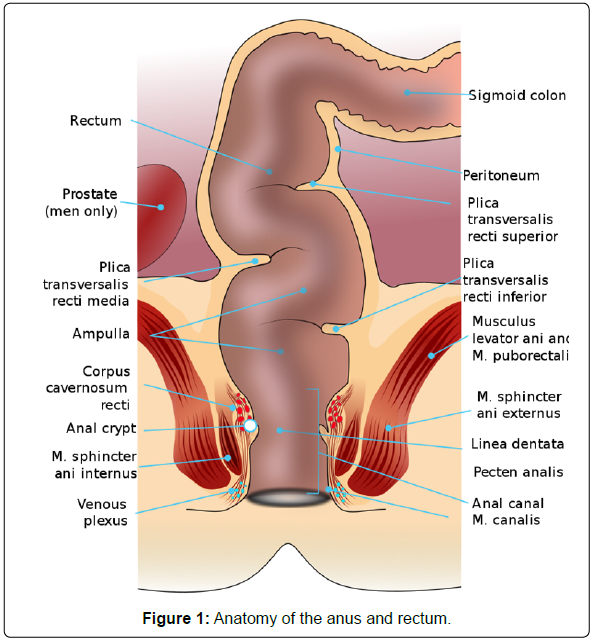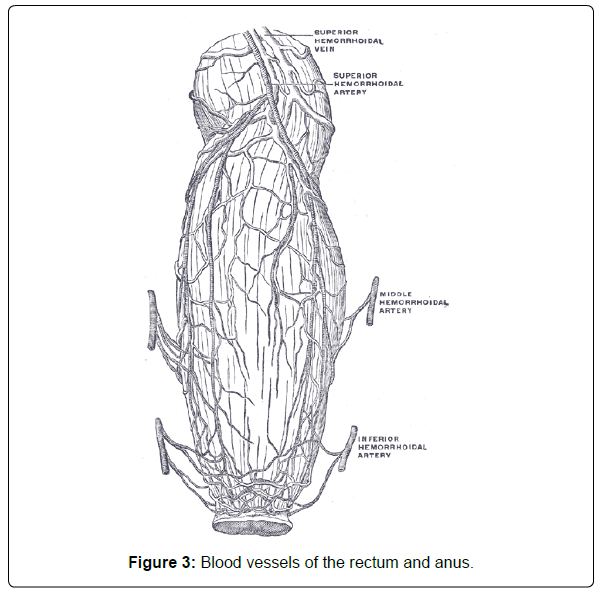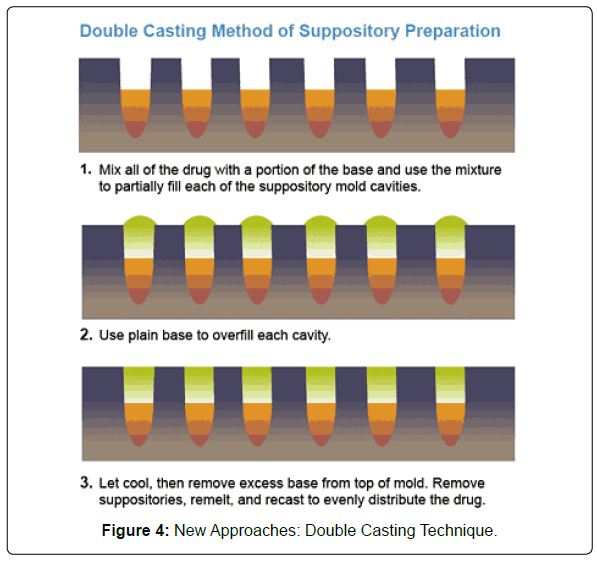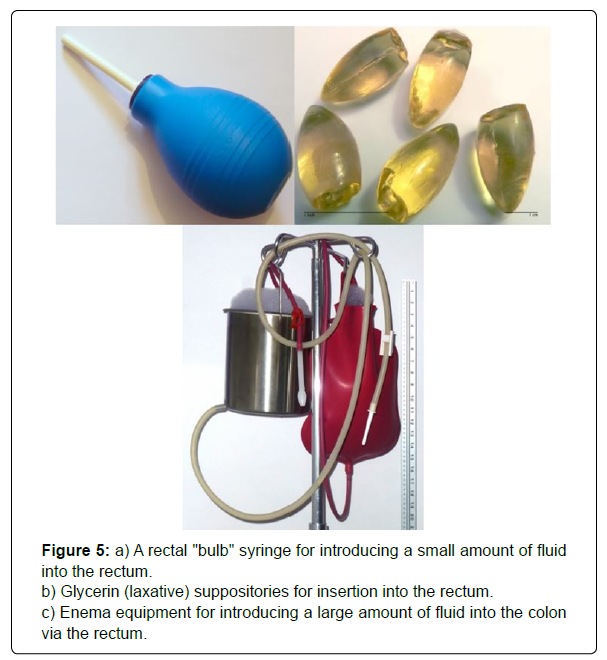Rectal Drug Delivery System: An Overview
Received: 17-Apr-2021 / Accepted Date: 21-May-2021 / Published Date: 28-May-2021
Abstract
Rectal drug delivery is a viable alternative to oral and parenteral routes of administration for protein-peptide drugs, since it prevents first-pass metabolism and delivery. Rectal administration enables both local and systemic therapy of drugs. The rectal drug delivery system is a useful alternative for patients who cannot swallow or are unconscious, to the oral route of administration. Traditional rectal dosages have previously been used for localized treatments, including antipyretic delivery, hemorrhoid delivery, and laxative delivery the ongoing research and development in this area of drug delivery systems may unlock the hidden potential of the rectal drug delivery system. The present review provides various advantages and disadvantages, optimizations and criteria for drug selection. The anatomy and physiology of the rectum, dosage types, and factors involved in rectum drug absorption, absorption barriers, and absorption enhancers for use and evaluation are all discussed. Polymers used for the rectal drug delivery route are also discussed in this review.
Keywords
Rectal drug delivery system; RDDS; DDS; Mucoadhesive drug delivery
Introduction
Rectal drug delivery refers to the administration of drugs or medications via the rectum for local or systemic effects. A type of mucosal adhesive drug delivery system is a rectal drug delivery system. These systems provide mucoadhesion, i.e. the drug's attachment to the mucous membrane along with an effective carrier [1]. Rectally administered hydrogels have shown that hydrogels use hydroxyethyl methacrylate as a model drug to provide rate-controlled drug delivery cross-linked with ethylene glycol dimethacrylate, including antipyrine and theophylline [2,3]. For a long period of time, the rectal route was used only for local anesthetic, anti-hemorrhoidal, vermifuge, antibacterial and laxative administration [4].
Main Text
Advantages [5]
• Stomach and small intestine exasperation associated with such medications can be avoided. Example- Aspirin, ibuprofen, naproxen: non-steroidal anti-inflammatory drugs.
• Absorption of many drugs, peptides, and low-molecular-weight proteins is increased.
• To prevent acid and enzymatic degradation of such drugs, avoid interaction with digestive juices. Example - Rectal delivery of protein peptide drugs provide low levels of protease activity, particularly of pancreatic origin.
• It is possible to partly prevent hepatic first-pass elimination of high clearance drugs. Lidocaine, Morphine, Proponalol, for instance.
• In geriatric, pediatric, and unconscious patients, especially those with difficulty swallowing oral medicines, rectal drug delivery is helpful.
• If oral intake is reduced, such as before x-ray tests, before surgery, or in patients with upper gastrointestinal tract.
• Drug delivery can be prevented by adjusting the type of dosage and the absorption of medications that can be discontinued in cases of accidental overdose or suicide.
• Drugs that are usually only parentally administered can be administered rectally. For example -Peptides and others.
Drawbacks [6]
• Throughout the rectal mucosa, many medications are inadequately or unevenly absorbed.
• Dissolution issues because of the rectum's limited fluid volume.
• Metabolism of drugs by microorganisms and rectal mucosa.
• They are uncomfortable and not selected by patients.
• Because of leakage or discharge following insertion, it is also unpredictable.
Improvement of drug absorption
Absorption enhancers: (such as salicylate bile salt fatty acids), pH control, and Solubilizing agents.
Standards for drug selection
• Elevated therapeutic doses of drugs are required.
• Medications with swallowing difficulties. Drugs such as Proteins & Peptides are substrates for proteolytic activity in the upper Gastrointestinal tract.
• Eliminate medications that have a lesser half-life. Drugs which have decreased bioavailability.
• Drugs that need regular dosing. A medication in the oral mucosa that demonstrates a local effect.
Anatomy and physiology of rectum
The four layers of tissue described in the basic structure of the gastrointestinal tract (Figure 1) are present in the colon, the rectum and the anal canal In the colon, the arrangement of longitudinal muscle fibres is changed. They don't form a single layer of tissue, but rather three bands called taeniae coli that are spread out across the colon at regular intervals. They come to a halt at the rectum-sigmoid colon junction. Since these bands of muscle tissue are significantly shorter than the colon's total length, the organ appears sacculated or puckered (Figure 1). As in the basic structure, the longitudinal muscle fibres stretch out and fully surround the rectum and the anal canal The circular muscle layer thickens to form the anal sphincters. There is more lymphoid tissue in the submucosal layer than anywhere else in the alimentary tract, offering non-specific protection against invasion by resident and other microbes. Large numbers of goblet cells form simple tubular glands that secrete mucus in the mucosal lining of the colon and the upper region of the rectum. They don't live outside the rectum's and anus's junction. The anus lining membrane is made up of stratified squamous epithelium that is continuous with the rectum's mucous membrane lining above and merges with the skin. The anus lining membrane is made up of stratified squamous epithelium that runs parallel to the rectum's mucous membrane lining and merges with the skin beyond the external anal sphincter. The mucous membrane in the upper portion of the anal canal is arranged in 6 to 10 vertical folds called anal columns. A terminal branch of the superior rectal artery and vein can be found in each column [7].
Blood supply: The superior and inferior mesenteric arteries have the bulk of arterial supply (Figures 2 and 3). The caecum, ascending, and much of the transverse mesenteric arteries are supplied by the superior mesenteric artery. The remainder of the colon and the proximal portion of the rectum are supplied by the inferior mesenteric artery. Branches from the internal iliac arteries supply the distal portion of the rectum and the anus. The superior and inferior mesenteric veins, which pump blood from the same-named arteries, are the major sources of venous drainage The portal vein is formed when these veins join the splenic and gastric veins (Figures 2 and 3). The internal iliac veins enter the veins draining the distal part of the rectum and the anus [7].
Absorption of drugs in rectum
There are two transport pathways for drug absorption from the rectal epithelium: transcellular and paracellular routes. The transcellular pathway's absorption mechanism depends on lipophilicity, where the paracellular pathway is the diffusion of drugs across the space between epithelial cells. Aqueous and alcoholic solutions are absorbed quickly, while suspensions and suppositories are absorbed slowly and continuously. Alkaline solutions absorb faster than acidic solutions[8,9].
Methods to enhance the drug's rectal absorption include: (i) Changes in the function of the mucosal membrane barrier. (ii) To boost the partition coefficient, chemically modified drugs.
Methods
• In any of the following ways, rectal administration of medication can be carried out:
• In the rectum, a suppository is inserted (Figure 5a).
• A small volume (usually less than 10 milliliters) of a liquid-drug solution injected into the rectum is a micro-enema(Figure 5b).
• With a large enema, a liquid drug solution is injected into the colon (Figure 5c).
• A specialized catheter designed for the rectal administration of medicines and liquids that can be safely inserted and, for repeated use, remain comfortably in the rectum.
Factors Involved In Drug Absorption From Rectum Physiologic factors
• Colonic content- When the rectum is empty, the medication may have a greater opportunity to get absorbed.
• Weaker acids and bases in rectal have a higher pH, and strongly ionised acids and bases are consumed faster.
Physicochemical factors
• Degree of ionization- Unionized drugs are highly absorbed due to their high degree of ionization.
• Particle size - The smaller the particle size, the greater the wear resistance, and the better the polishability. Improving intestinal/ rectal absorption of medications that are poorly absorbed[10].
Physical modification
The higher the concentration, the greater the solubility, and the more effective the drug transfer will be. For optimizing absorption, the formulations are effective in various bases.
Chemical modification
To increase the solubility of medications that are so poorly aqueous and soluble in order to maximize dissolution. In order to boost membrane affinity, it is also important to increase the partition coefficient and decrease the formation of hydrogen bonds[11].
Formulation modification
• Poorly aqueous soluble drugs to improve the development of the dissolution stage included a combination formulation modification technique and barrier system (example: insulin suppository).
• Transfer from the vehicle in the suppository formulation via the membrane through the rectum into the hemorrhoid veins in osmosis process of drugs.
• Transcellular and paracellular routes are dependent on lipophilicity and are involved in a traditional transcellular route of transport. The mechanism of paracellular transport implies that drugs spread through the gap between epithelial cells[12].
Absorption barriers
(a) Mucus layer (b) Movable water layer (c) Chemical barriers
Application of Rectal Drug Delivery [13] Anti-epileptic drugs are given rectally
• It is possible to prevent antiepileptic drugs' first-pass metabolism to some degree.
• The diazepam solution is absorbed rapidly and fully, with a peak plasma concentration reaching within 5-15 minutes.
• Carbamazepine, lamotrigine, levetiracetam, phenobarbital, topiramate, and valproate rectal formulations were found to be bioequivalent to oral tablets and oral suspensions.
Analgesics by rectal route
Morphine controlled-release suppositories are used to a greater degree (larger AUC) than oral controlled-release tablets. It was also used to study pharmacokinetic interactions and drug effects in the steady-state intensity time course [14].
Absorption Enhancers [15]
• Chemical modification such as Acyl derivatives of insulin
• Enamine derivatives
• Fatty acids
• Strong chelating agents
• Rectal absorption of hydrophilic antibiotics and polypeptides is facilitated by salicylates and their derivatives.
• Protease inhibitors
• Cyclodextrins in drug delivery in the rectal cavity (Table 1)
| Category | Indication | Adverse effects |
|---|---|---|
| Local anesthetics | Anal pain of strangulated hemorrhoids, anal fissure and post anal surgery | Local irritation and anal cryptitis or proctitis |
| Steroids | Hemorrhoids, anal fissures, pruritus ani | Systemic absorption on local use |
| Astringents | Anal cryptitis, Hemorrhoids, pruritus ani | Local reaction |
| Vasoconstrictors | Hemorrhoids. Hemorrhoidal thrombosis | Headache, flushing, tachycardia |
| Antiseptics | Proctitis, anal cryptitis, anal fissures | Pruritus, local irritation, burning |
Table 1: Uses of Cyclodextrins in rectal delivery of drugs.
Different Types of Rectal Dosage Forms
• Creams, gels, ointments, and suppositories are semisolids used in the rectal region.
• Solutions and Suspensions for Rectal Liquids
• Rectal aerosols Rectal cream, gels, and ointments: The drugs include astringents such as Zinc oxide, Local anesthetics such as Pramoxine HCL, Protectants, and lubricants such as Cocoa butter, lanolin and Anti-inflammatory agents such as Hydrocortisone They're commonly used as a topical application for anorectal pruritis, inflammation, and the pain and discomfort that comes with it.
Rectal Suppositories [16]
• Torpedo-shaped solid dosage forms that include watersoluble bases (dissolving) or fatty bases (low-melting) that range in weight from 1 g (children) to 2.5 g are typically rectal suppositories (adults).
• The composition of the suppository base is responsible for both the rate and degree of drug release.
• In fatty base suppositories, hydrophilic drugs are formulated, while lipophilic drugs are typically inserted into water-soluble bases. • Melting can occur rapidly near body temperature (37°C) for suppositories made from fatty bases (Table 2).
| CDs | Improvements | Drugs |
|---|---|---|
| a-CD | Stability Release and/or Permeation |
Morphine HClCefmetazole, Morphine HCI |
| b-CD | Stability Release and/or Permeation | Carmofur Naproxen, Phenobarbital |
| g-CD | Release and/or Permeation | Diazepam, Flurbiprofen |
| DM-C | Release and/or Permeation Local irritation |
Diazepam, Insulin 4-biphenylacetic acid |
| TM-b-CD | Release and/or Permeation | Diazepam, Flurbiprofen |
| b-CD polymer | Selective transfer into lymphatics | Carmofur |
Table 2: Suppository bases.
| Vehicle | Melting range (°C) | Solidification point (°C) |
|---|---|---|
| Fatty Bases | ||
| Witepsol | 32-44 | 27-38 |
| Cocoa butter | 30-35 | 24 |
| Hard butters | 36-45 | 32-40 |
| Estarinum | 29-50 | 26-40 |
| Water soluble | ||
| Myrj 51 | 39-42 | 39 |
| PEG a | 38-49 | 38-42 |
| Tween 61 | 35-49 | - |
Table 3: Category of Suppositories Indication and adverse effects.
• The resultant would easily melt and flow to provide the rectal tissue with small, wide coverage, thus minimizing lag time effects due to the slow release of the drug from the suppository base.
Methods of Preparation of suppositories [16]
(I) Hand Rolling (II) Compression Molding (III) Fusion/ Pour Molding
New Approach- Double Casting Technique (Figure 5) [17]
• After lubrication, the suppository is packaged with enough lubricant in aluminum foil or other suitable material and inkling [KEEP IN A COOL PLACE].
• ANUSOL HC (Hydrocortisone), CANASA (Mesalamine), DULCOLAX (Bisacodyl), NUMORPHAN (Oxymorphone), PANADOL (Paracetamol), and others include some commercial suppository items.
• Acetaminophen Glycero-Gelatin Laxative Eucalyptol Anucort-HC
Rectal Liquids [16]
• Rectal dosage forms with: Very limited uses, which are mostly due to inconvenience and poor patient compliance.
• In multiple cases, these formulations are used to administer contrast media and imaging agents for lower Gastro-Intestinal (GI) roentgenography. It normally involves injecting a liquid (laxative) into the rectum with a syringe.
• Retention enema: This dosage type is used to administer medications such as aminophylline (systemic effect) or hydrocortisone (local effect).
Rectal Aerosols [16]
• Rectal aerosols or foam items are added to aid administration by applicators. They are connected to the bottle and loaded with a dosage of substance that has been weighed.
• Aerosols with specific doses are available. The inserter is placed into the anus and by pushing the plunger, the medication substance is administered.
• Such as CORTIFOAM (Hydrocortisone), PROCTOFOAM HC are some sold rectal aerosols (Pramoxine)
Evaluation of Suppositories [18-21]
Weight variation
• All suppositories are measured and estimated using the average weight.
• No suppositories should vary by more than 5 percent from the average weight, except two, which may differ by no more than 7.5 percent.
Disintegration test
• The disintegration procedure is carried out using a tablet disintegration test apparatus on six suppositories.
• 160 ml of distilled water is used at 37°C as a medium.
• Determine the time required to completely disintegrate the suppository.
Breaking Test
• It is intended as a technique to calculate fragility or brittleness.
• Water at 37°C is pumped into the apparatus's double wall chamber.
• The ideal breakpoints are defined as the level that withstands the break forces caused by manufacturing, packaging, shipping, and storage for different shaped suppositories.
Macro Melting Range Test
The temperature is slowly increased and the temperature at which the mass liquefies is recorded for the macro melting range test. The formulation is filled into 10 cm long capillary tubes to a height of around 1 cm and dipped into a water-containing beaker.
Drug Content
For the determination of drug content, the suppositories are dissolved in a suitable solvent.
Liquefaction Time & Temperature
• Using a fabricated instrument, liquefaction/ softening time and temperature can be calculated.
• A large pipette on one side with a narrow opening and a wide opening on the other side is used. The pipette is dipped in hot water kept at 37°C so that the narrow end faces hot water.
Dissolution Test
• In vitro dissolution tests of suppositories are carried out using a wire mesh basket or a membrane to isolate the sample chamber from the reservoir in the tablet dissolution test apparatus.
• One suppository is used as a dissolution medium in each test at a specified rpm using a buffer at 37 ± 0.5° C.
• At predetermined time intervals 5 ml samples are withdrawn by means of a syringe fitted with a pre-filter then filtered through Whatman filter paper. The volume withdrawn at each interval is replaced with the same quantity of fresh dissolution medium and maintained at 37 ± 0.5°C.
• The sample is analyzed for drug release by measuring the absorbance at particular nm using a UV visible spectrophotometer after a suitable withdrawn sample.
Conclusion
The rectal drug delivery system provides patients with a less invasive option, and the drug can be given to children, the elderly, and patients who are unconscious. Rectal drug delivery with the benefits of enhancing drug absorption with enhancers and its effectiveness as a sustained-release formulation for the long-term treatment of chronic diseases will surely be a pioneer in the formulation of several challenging compounds. Thus, by improving some technologies to improve patient acceptability, rectal administration can lead to wider adoption of drug administration routes. It is also used to treat unconscious and pediatric patients, and for the treatment of pregnancy. Despite its benefits, the rectal route for drug delivery is still largely under-utilized. There are a variety of conditions that have been discussed, although the oral route is the most convenient and preferred route for drug administration, whereas this fact is not possible from either a clinical or pharmaceutical perspective. In these cases, both for local and systemic action, the rectal route may be used to administer medications and can represent a practical alternative. Comprehensive studies on the biological interactions of rectal drug delivery and continued innovations in rectal drug formulation are required to fully exploit the potential of this route to treat systemic and local diseases, chemotherapy, and allergyinduced emesis. We conclude that not only the production of new drugs is important, but also the optimization of the different routes of administration to optimize efficacy and minimize adverse effects.
References
- www.encyclopedia.com
- Van Hoogdalem EJ, de Boer AG, Breimer DD (1991) Pharmacokinetics of rectal drug administration, part I: general considerations and clinical applications of centrally acting drugs. Clin Pharmacokinet 21:11-26.
- Van Hoogdalem EJ, de Boer AG, Breimer DD (1991) Pharmacokinetics of rectal drug administration, part II: clinical applications of peripherally acting drugs and conclusions. Clin Pharmacokinetics 21:110-128.
- Baviskar P, Bedse A, Sadique S, Kunde V, Jaiswal S (2013) Drug Delivery on Rectal Absorption: Suppositories. Int J Pharm Sci Rev Res 21:70-76.
- Boylan JC, Swarbrick J (2009) Encyclopedia of pharmaceutical technology vol-I, 2nd edition. Pp:32-940.
- Baviskar P, Jaiswal S, Sadique S, Landged A (2013) Formulation and Evaluation of Lornoxicam Suppositories. The Pharma Innovation J 2:20.
- Waugh A, Grant A (2004) Ross and Wilson: Anatomy and Physiology in Health and Illness. (9th edn). Churchill Livingstone pp:304-305.
- Lakshmi Prasanna J, Deepthi B, Rama Rao N (2012) Rectal drug delivery: A promising route for enhancing drug absorption. Asian J Res Pharm Sci 2:143-149.
- Baviskar P, Bedse A, Sadique S, Kunde V, Jaiswal S (2013) Drug Delivery on Rectal Absorption: suppositories. Int J Pharm Sci Rev Res 21:70-76.
- De Boer AG, Breimer DD (1997) Hepatic first-pass effect and controlled drug delivery following rectal administration. Adv Drug Delivery Rev 28:229-237.
- Abd-el-maeboud KH, El-naggar T, El-hawi EM, Mahmoud SA, Abd-el-Hay S (1991) Rectal suppositories: commonsense and mode of insertion. Lancet 338:798-800.
- Rejman F (1962) Use of Roinal suppositories in patients with anorectal complaints. Europe PMC 78:727-729.
- Watanabe YE, Hoosdalem JA, De Boer AG (2008) Absorption enhancement of rectally infused cefoxitin by medium chaim monoglyderides in conscious rats. J Pharm Sci 77:47-84.
- De Leede LG, De Bow AG, VeILen SL, Breimcr DD (2006) Zero-order rectal delivery of theophylline in man with an osmotic temp. J Pharmacokin Biopharm 119:525-537.
- Muranishi S (1990) Absorption enhancers. Crit Rev Ther Drug Carrier Syst 7:l-33.
- Singh J, Jayaswal SB (1985) Formulation, bioavailability and pharmacokinetics of rectal administration of lorazepam suppositories and comparison with oral solution in mongrel dog. Pharm Ind 47:664-668.
- Yoshihawa H, Takada K, Muranishi S (1984) Molecular weight dependence of permeation electivity to rat small intestinal blood lymph barrier for exogenous macromolecules absorbed from lumen. J Pharmacobio-Dyn 7:1-6.
- Bocci V (1984) Evaluation of route of administration of interferon’s in cancer: a review and a proposal. Cancer Drug Deliver 1:337-351.
- Tangri P, Khurana S, Madhav NV (2011) Mucoadhesive drug delivery: Mechanism and methods of evaluation. Int J Pharm Bio Sci 2.
- https://www.slideshare.net/chiranjibi68/rectal-drug-delivery-systems
- Sadikali S (2013) Formulation and evaluation of lornoxicam suppositories. The Pharma Innovation J 2:20-28.
Citation: UlHaq MM (2021) Rectal Drug Delivery System: An Overview. Clin Pharmacol Biopharm, 10: 219.
Copyright: © 2021 UlHaq MM. This is an open-access article distributed under the terms of the Creative Commons Attribution License, which permits unrestricted use, distribution, and reproduction in any medium, provided the original author and source are credited.
Share This Article
Recommended Journals
Open Access Journals
Article Usage
- Total views: 2483
- [From(publication date): 0-2021 - Apr 01, 2025]
- Breakdown by view type
- HTML page views: 1716
- PDF downloads: 767





